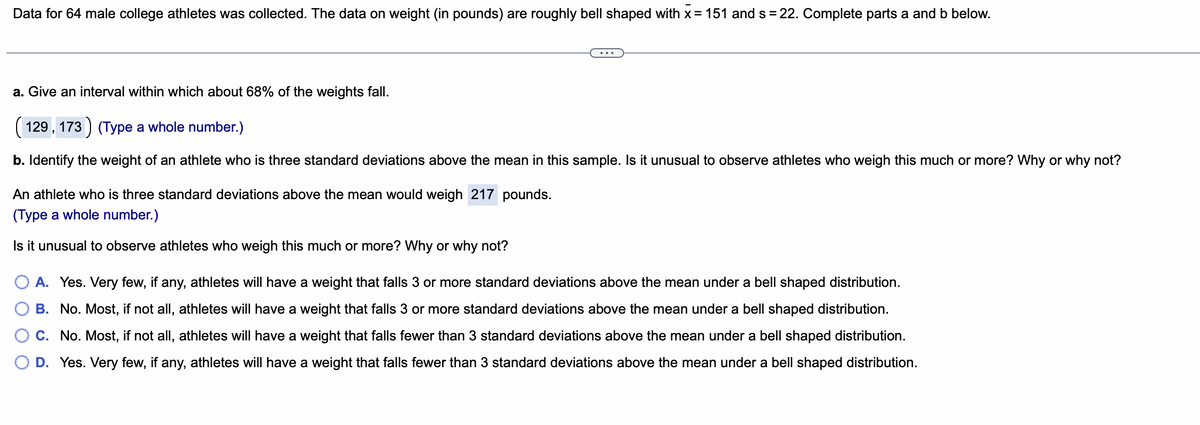An athlete who is three standard deviations above the mean would weigh 217 pounds. (Type a whole number.) Is it unusual to observe athletes who weigh this much or more? Why or why not? O A. Yes. Very few, if any, athletes will have a weight that falls 3 or more standard deviations above the mean under a bell shaped distribution. O B. No. Most, if not all, athletes will have a weight that falls 3 or more standard deviations above the mean under a bell shaped distribution. OC. No. Most, if not all, athletes will have a weight that falls fewer than 3 standard deviations above the mean under a bell shaped distribution. O D. Yes. Very few, if any, athletes will have a weight that falls fewer than standard deviations above the mean under a bell shaped distribution.
An athlete who is three standard deviations above the mean would weigh 217 pounds. (Type a whole number.) Is it unusual to observe athletes who weigh this much or more? Why or why not? O A. Yes. Very few, if any, athletes will have a weight that falls 3 or more standard deviations above the mean under a bell shaped distribution. O B. No. Most, if not all, athletes will have a weight that falls 3 or more standard deviations above the mean under a bell shaped distribution. OC. No. Most, if not all, athletes will have a weight that falls fewer than 3 standard deviations above the mean under a bell shaped distribution. O D. Yes. Very few, if any, athletes will have a weight that falls fewer than standard deviations above the mean under a bell shaped distribution.
Glencoe Algebra 1, Student Edition, 9780079039897, 0079039898, 2018
18th Edition
ISBN:9780079039897
Author:Carter
Publisher:Carter
Chapter10: Statistics
Section10.4: Distributions Of Data
Problem 19PFA
Related questions
Question
5.

Transcribed Image Text:Data for 64 male college athletes was collected. The data on weight (in pounds) are roughly bell shaped with x = 151 and s= 22. Complete parts a and b below.
a. Give an interval within which about 68% of the weights fall.
(129, 173) (Type a whole number.)
b. Identify the weight of an athlete who is three standard deviations above the mean in this sample. Is it unusual to observe athletes who weigh this much or more? Why or why not?
An athlete who is three standard deviations above the mean would weigh 217 pounds.
(Type a whole number.)
Is it unusual to observe athletes who weigh this much or more? Why or why not?
A. Yes. Very few, if any, athletes will have a weight that falls 3 or more standard deviations above the mean under a bell shaped distribution.
B. No. Most, if not all, athletes will have a weight that falls 3 or more standard deviations above the mean under a bell shaped distribution.
C. No. Most, if not all, athletes will have a weight that falls fewer than 3 standard deviations above the mean under a bell shaped distribution.
D. Yes. Very few, if any, athletes will have a weight that falls fewer than 3 standard deviations above the mean under a bell shaped distribution.
Expert Solution
This question has been solved!
Explore an expertly crafted, step-by-step solution for a thorough understanding of key concepts.
This is a popular solution!
Trending now
This is a popular solution!
Step by step
Solved in 2 steps

Recommended textbooks for you

Glencoe Algebra 1, Student Edition, 9780079039897…
Algebra
ISBN:
9780079039897
Author:
Carter
Publisher:
McGraw Hill

Glencoe Algebra 1, Student Edition, 9780079039897…
Algebra
ISBN:
9780079039897
Author:
Carter
Publisher:
McGraw Hill